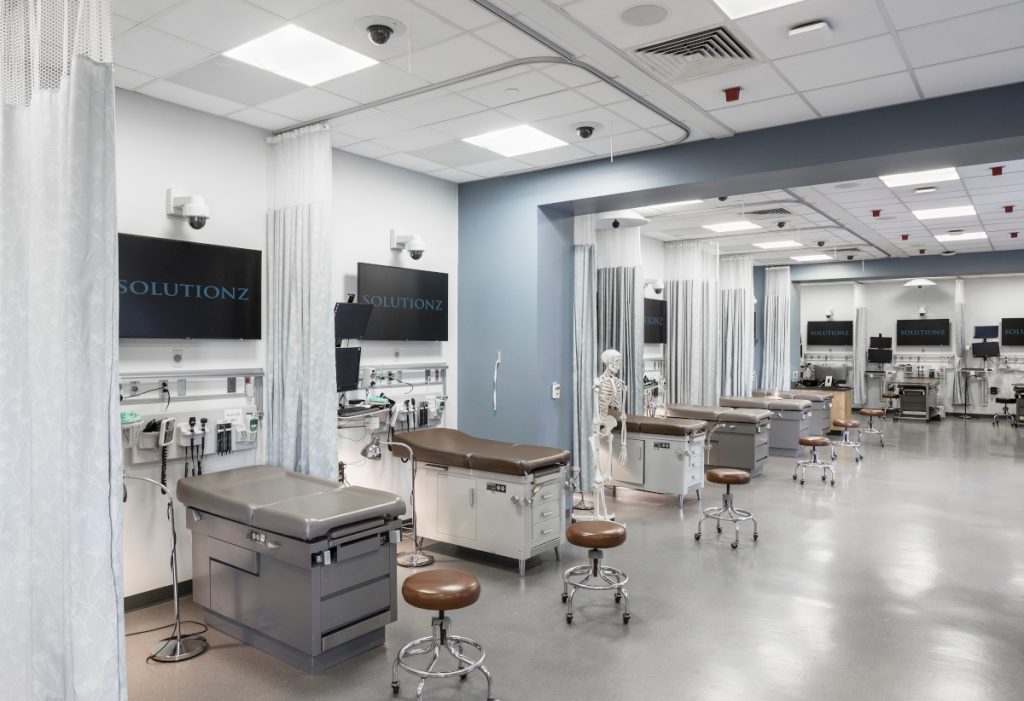Networked solutions and innovation give UPenn’s nursing students an edge.
“Ten years is a lifetime in technology terms,” said Christian Alexy, IT Director at the University of Pennsylvania’s School of Nursing in Philadelphia PA, remarking on the abbreviated lifespan of AV systems. That lifespan has been made even briefer by AV’s ongoing merger with the IT domain, as well as the concomitant shift from hardware to software platforms over the last decade. Ten years was the length of time since the teaching-simulation systems at the university’s Claire M. Fagin Hall, home to the university’s School of Nursing, had been updated. “The systems [were] installed in 2012, but the design had been done in 2010,” Alexy added, “so all the technology was really 10 years old. And so much had changed in that time.”
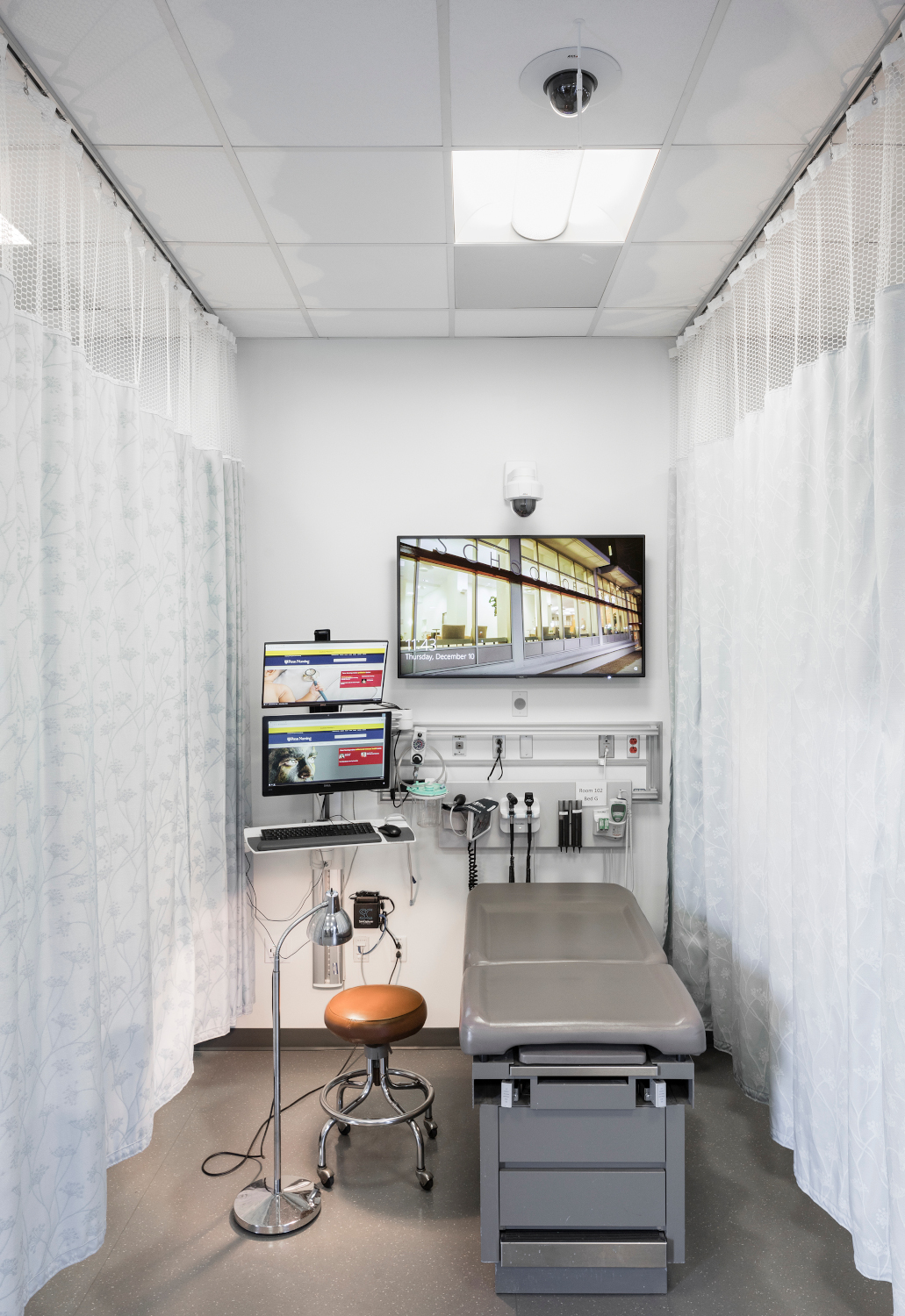
A lot was on the line for Penn Nursing, the moniker by which the award-winning program there—it’s actually the number-one-ranked nursing school in the world, per QS World University Rankings—is known locally. It had to maintain its education edge, much of which is derived from medical-simulation systems that give students a viscerally realistic patient experience. The onset of the novel coronavirus (COVID-19) pandemic, which closed down the college late last April, further accelerated the need for a “technology refresh,” as Alexy called the $1 million-plus project. The refresh entailed moving new AV and control systems, including Crestron’s NVX and QSC’s Q-SYS Core 510i, onto the university’s existing, Juniperbased IP backbone.
“We had to be back up and ready for classes in late June,” Alexy revealed. “As complex as the project was, the pandemic was [the] single biggest challenge.” With the time window being that tight, there was little opportunity to examine the irony of a medical catastrophe impeding a medical teaching facility’s completion.
Overview
The bones of what would come to constitute a digital overhaul of Penn Nursing’s medical-simulation systems were put in place back in 2012 by Solutionz, Inc., the same AV integrator that, along with designer Phase Shift Consulting, would work with the education institution for this major refresh. The facility contains multiple spaces that emulate various healthcare settings, with technical systems to record student/patient interactions, facilitate communications among staff observers and display lecture content. There are 27 student observation bays divided into three classrooms/practice rooms (four in Room 100, 18 in Room 102 and five in Room 104); four high-definition observation rooms; a home-care simulation suite; and multiple support spaces.
As part of the renovation project, the prior simulation system—it had used analog audio and video links between its head end and student spaces, and it had occupied numerous full-height equipment racks—was demolished. In its place is a fully IP-based solution that has a dramatically reduced footprint; the reclaimed space was converted into staff office space. The new solution incorporates QSC and Shure audio-over-IP devices utilizing Dante, a Crestron NVX video-over-IP system, Axis Communications IP pan-tilt-zoom (PTZ) cameras and B-Line Systems video-capture encoders.
Closely coordinating with the School of Nursing’s IT staff, Solutionz was able to utilize the building’s existing, Juniper-based network for all AV traffic. This not only leverages IT assets that the university already owned, but will also allow future lecturers and observers to be located outside of Fagin Hall. This project began in 2019, and it was completed in 2020. Despite the two-month, pandemic-induced shutdown, the team’s efforts ensured that it finished on schedule and on budget.
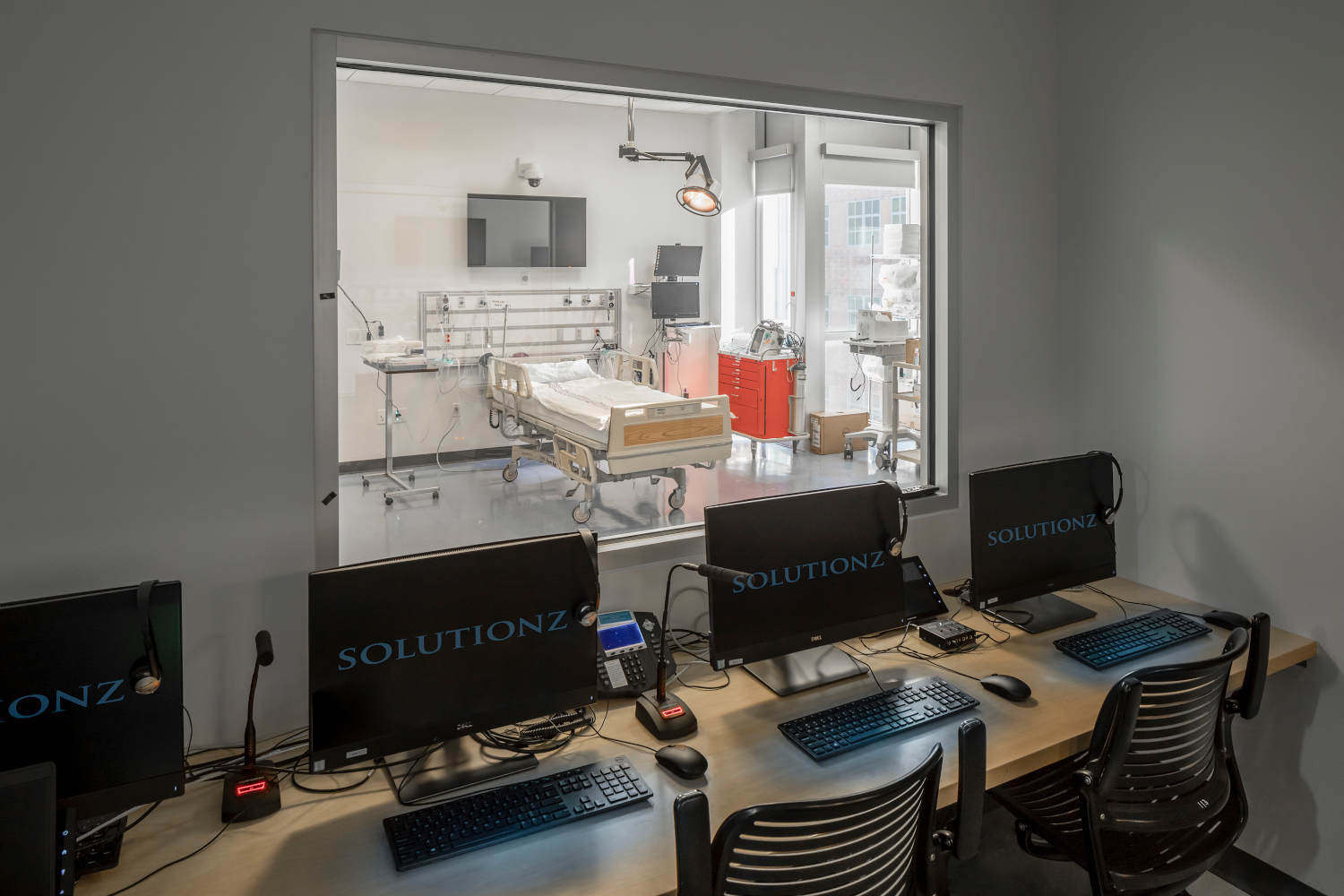
AVoIP Is The Backbone
“The fact that this is an IP-based project was the outcome, rather than the goal,” Evan Chadwick, an Associate at Phase Shift Consulting, which did the design and specifications for the Penn Nursing project, stated. Whereas some projects on the cusp of the larger migration from linear to networked models are intentional from their very inception, others, like this one, evolved. Here, the client sought to repurpose much of the equipment space that was being used by the previous AV-technology iteration.
According to Chadwick, at the time the university brought in Phase Shift Consulting as the project designer, the initial plan was to use an HDBaseT topology as the backbone for the AV components. However, the university’s desire for more space led to the consultant looking at IP as a way for the systems to take up even less room. Most notably, this entailed putting the audio, video and control systems on two existing university virtual local area networks (VLANs)—one for Dante and NVX, and the other for control and cameras. B-Line Systems, whose software is at the core of the lab’s operation, and whose latest iterations were well suited
for networked integration, encouraged that
consideration.
“Essentially, [the university] had been promised that the B-Line Systems physical footprint would be much smaller,” Chadwick explained, “[and that] started the wheels turning about whether or not they could make the physical footprint of the associated AV devices smaller.” He continued, “And moving to IP distribution for any one service causes a cascade effect. You move to a video-over-IP system and the video-encoding platform uses Dante audio streams, so it makes sense to use Dante to ingest other programaudio sources into your system, which leads to [asking] what microphones you’re going to specify. Now, you already have a Dante platform, so it makes sense to specify Danteenabled microphones. And, by the time all these little threads are pulled, you end up with all the devices sitting on the network.”
Before the first video display or audio speaker was hung, the question of how to in tegrate all those components into an existing network required resolving. “The coordination of all this becomes a challenge because we’re putting a lot of traffic, and utilizing a lot of ports, on the client network,” Chadwick explained. “In fact, the client added over 300 ports, via additional switches, to their network to provide all the necessary additional connections. It was one of the major tasks just to coordinate the number of ports that were needed. Furthermore, we designed this system with PoE [Power over Ethernet] to reduce the number of power supplies in the equipment racks…. So, we had to choose devices that accommodated that. This necessitated getting really good documentation together for the IT team and the architect on the amount of current that the new system was expected to draw; [that] ultimately resulted in an additional cooler being installed in the IT-switch room.”
“Plus,” Chadwick continued, “the client’s existing network was Juniper based, [so] everything we specified was going to need to be operable on Juniper switches. That meant some legwork for us, discussing with QSC, Crestron and B-Line what their switching requirements are. Then, there are issues with making sure that all the devices can talk to each other. The IT team at Penn did a lot of work to set up the network appropriately to make sure that the traffic would [move synchronously]. It’s the most thoroughly IP system that I have ever personally been involved with.”
According to Chadwick, incorporating network-ready components is now a normal part of systems designs. What was unique here, however, was putting so many complete networked systems onto a client’s own network. “If we were going to deploy this for other clients, we typically would be designing [a dedicated] network and the integrator would be installing it,” he explained, “and
that network’s sole existence would be to service the system.” Chadwick continued, “In this case, the network serving the AV systems is the same network that gets students their internet access and [directs] email to professors. The thing that makes this system unique is that the client owns and manages this network.”
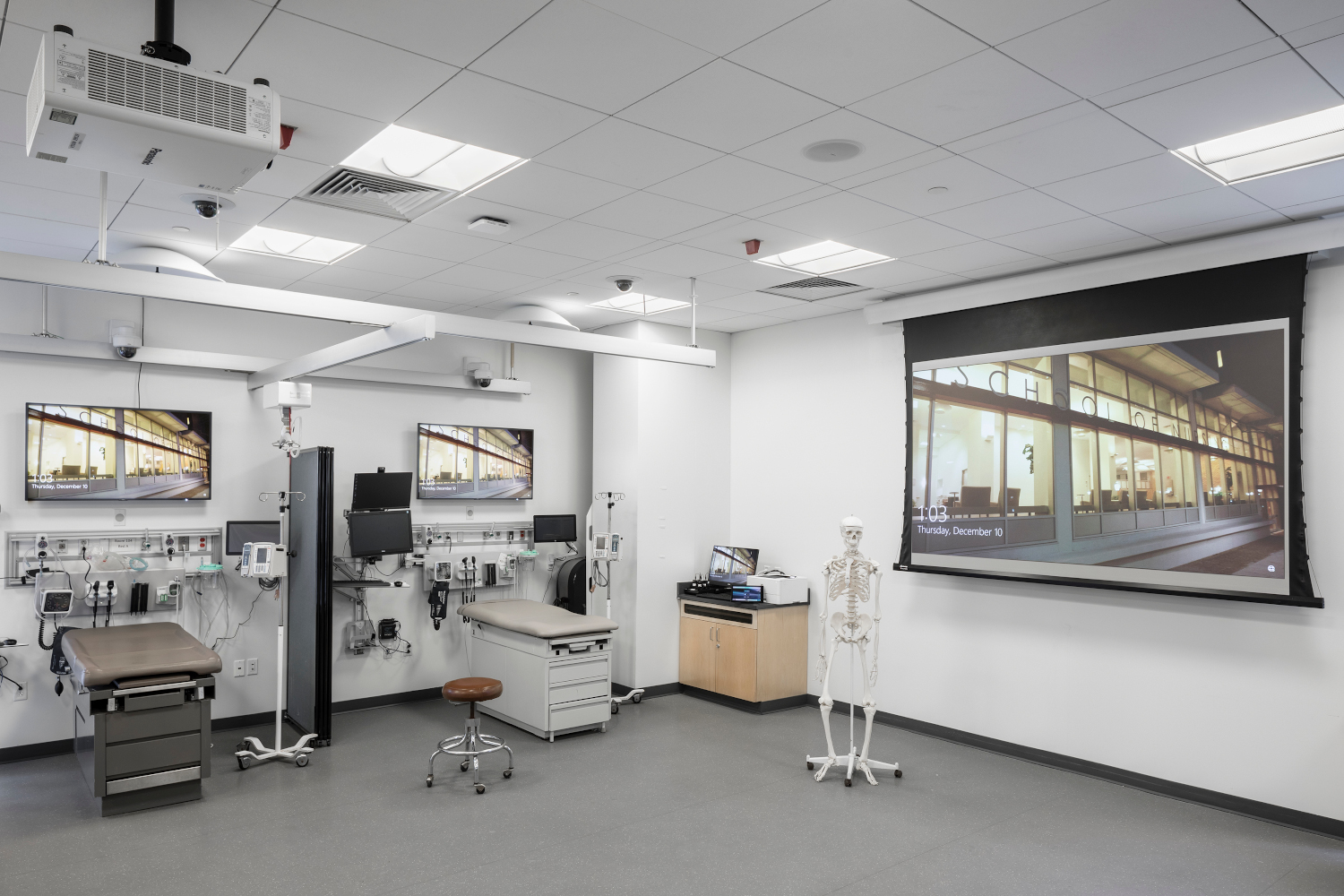
Even though putting large AV systems onto dedicated AV-over-IP networks greatly simplifies many aspects of design and integration, Chadwick cautioned that the trend comes with its own concerns. “With many AV system designers putting in dedicated switches, the client doesn’t always manage those switches,” he said. ”If this isn’t coordinated ahead of time, you end up with network switches around the facility that are not managed by the client’s IT team and [that] aren’t getting security patches, preventative maintenance, software updates, etc.” Chadwick added, “If this is the way that this industry is headed, it’s going to require a lot more coordination between IT teams at client sites and AV designers than [currently exists].”
The shift to an all-IP AV infrastructure required an even higher level of cooperation and coordination between the integrator, the consultant, the university/client and the general contractor, Solutionz’s Sales Account Executive, Joe Psiuk, emphasized. “This wasn’t the kind of project where the consultant threw down some blueprints and said, ‘Go for it,’” he said. “Instead, everyone involved was completely accessible, all the time.”
Indeed, they had to be because COVID-19 arrived not long after the project began. “A lot of the people working on this, including the systems programmers, were working remotely,” Psiuk said. As it turned out, the pandemic put considerably more importance on an aspect of AV projects that usually stays well in the background—namely, equipment procurement. “Getting everything to come into the warehouse on time, and in the right sequence, was more complicated than ever,” he acknowledged, citing, in particular, the dozens of IP cameras that the consultant specified. The pandemic forced thousands of businesses onto videoconferencing platforms, such as Zoom and Microsoft Teams; unsurprisingly, that led to huge demand and a precipitous shortage of all types of webcams. (The NPD Group, a market-research firm, reported a 179-percent jump in sales for webcams during the first three weeks of March, as consumers entered quarantine.)
“We sourced those, and other products, through a variety of distributors,” Psiuk recalled. “And if they weren’t in stock, we went directly to the manufacturers in some cases.” He credited Solutionz’s Production and Warehouse Manager, Mark English, and his staff with keeping it as orderly as it could be. “In some cases, we were splitting purchase orders between multiple vendors—and not just for cameras but [in fact for] almost everything on the lists. Sourcing during a pandemic, when supply chains were so overextended, was a project in and of itself.”
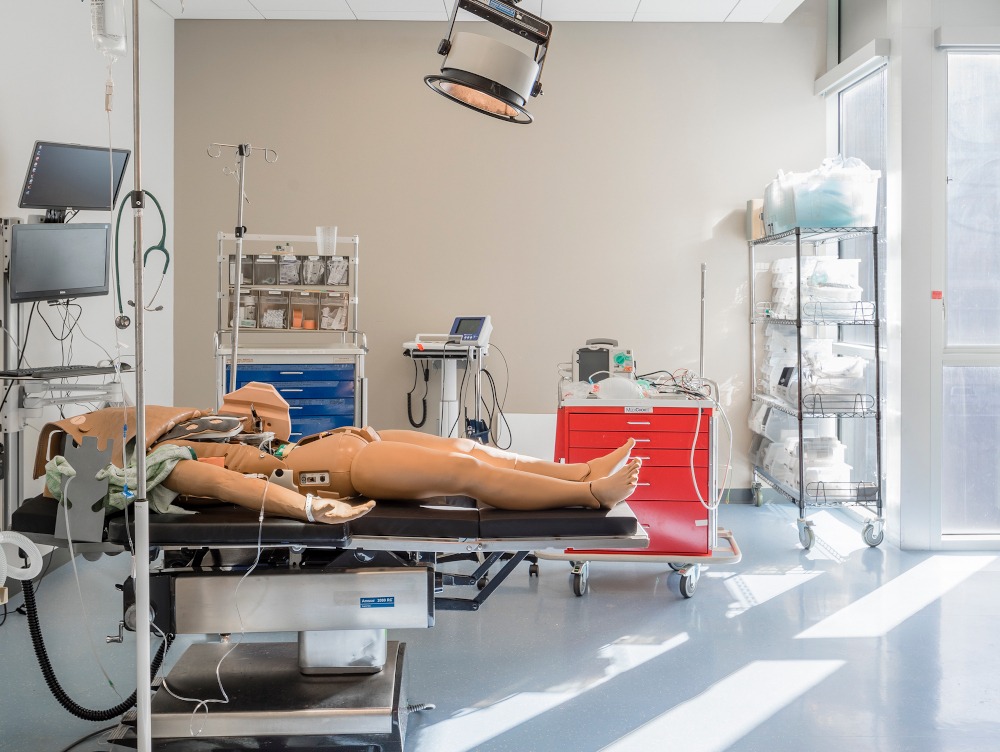
In The Bays—Audio
Penn Nursing’s 27 student observation bays, divided among three classrooms that resemble hospital wards, are the core installations for the project, and they are largely replicated in the four HD classrooms and in a simulated homecare suite. Each is identical in terms of its equipment, as follows: A 48-inch Sharp NEC LED display is wall mounted above the “patient” gurney (Penn utilizes simulation manikins for training), connected via the Crestron NVX AVoIP platform that is the basis for the new system’s networked signal transport and control, including a B-Line software-based recorder that can archive lessons and demonstrations for later student access.
“Instead of a receiver strapped to the back of each display with an HDMI cable, it’s just the Crestron DM-NVX-D80 card in the OPS [Open Pluggable Specification] slot and an Ethernet cable to their network,” Brian Dempsey, a Senior Field Engineer at Solutionz, said. “I was part of the team that installed the original nursing training system here [several] years ago, and the difference between then and now is night and day. Then, it was analog inputs and outputs and quite a lot of cabling. Now, [there is] far less wiring on the network. It’s much more efficient.” Content sharing on the display is done through Mersive’s Solstice screen-sharing app, which is integrated into the NVX platform, as well.
The system is also larger than before, with more AV endpoints—for instance, 120 Dante networked audio endpoints. Each bay has two microphones: one Audix M40W6S mic suspended overhead and another mic—an Audix GS1W—attached to the front of the video display. This assures that sound is picked up regardless of which direction instructors and students face in the bay. In addition, instructors can wear Shure MXW wireless lavalier mics with bodypack transmitters that allow instructors and trainees, via a return channel, to plug into headphone jacks and hear input
from supervisors in the control area between the two main teaching bays. There, they can select individual instruction stations via a 10-inch Crestron master panel.
In some cases, there are as many as four audio paths from each bay, all over Dante streams. All told, with handheld wireless units included, the new facility uses 140 microphones. Dempsey said he consulted with Shure about microphone management and he was told he was looking at the largest Dante matrix they’d ever seen, with the QSC Core 510i Q-SYS integrated core processors, used as the audio system’s digital signal processors (DSPs), using four 64-channel chassis. “Q-SYS was an important part of making this work because maximum flexibility was really what we were aiming for,” he explained. “For instance, if a teacher wants to hear feedback from any microphone, we just drag and drop another Dante output into the matrix and that does it.”
JBL 6.5-inch speakers dot the ceiling for public-address purposes, but, in addition, each bay is fitted with either a SoundTube high-directivity speaker or a Dakota Audio FA-602 narrow-dispersion speaker. (The latter speakers have been repurposed from the original installation.) This allows everyone working in a bay to hear input from the control area—it’s situated behind a mirrored pane of one-way glass—but keep the sound from spilling into adjacent bays. These can be opened or muted from the control area.
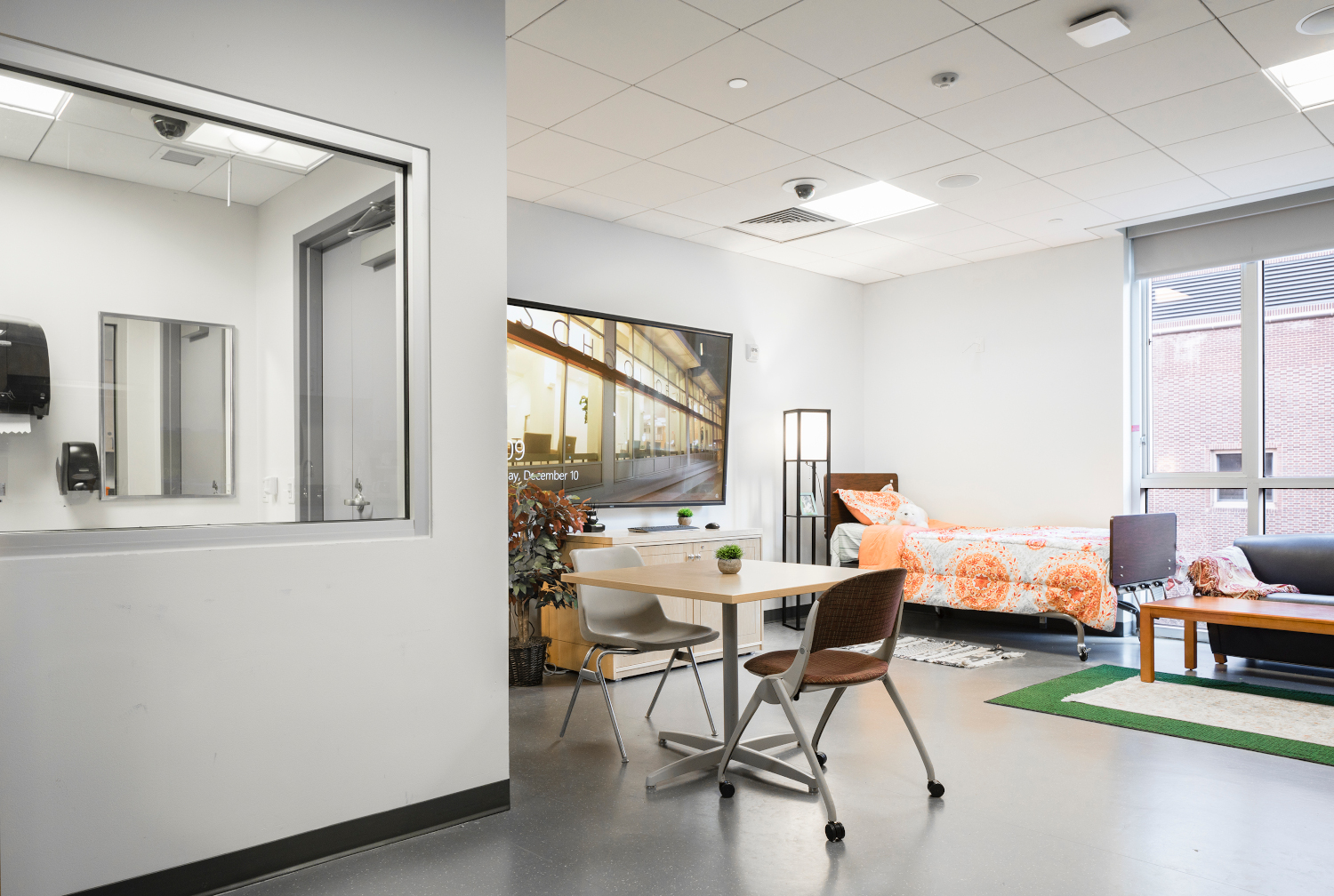
In The Bays—Video
Those observation bays have plenty of cameras, too—96 Axis Communications M5525-E IP cameras, in fact. They’re distributed, via H.264 streams, throughout the observation bays. There are two per bay: one ceiling mounted and one attached to the wall. “That way, we have an overhead view and a close-up look at the teaching process,” Dempsey said. Those signals are sent over the network to the B-Line encoders, and they’re viewable, in real time, on the control room’s Crestron touchpanel.
The four HD teaching suites have a similar AV complement to what outfits the main bays—but more! There are five cameras for each—four on the ceiling and one on the wall; there are six microphones—three ceiling mounted, two wireless lavaliers and one mounted on the wall. These are used for more intense, one-on-one instruction, Dempsey noted.
Programming the various endpoints on the networks, as well as the Crestron and QSC routing and DSP systems that support them, was an intensive task. However, Solutionz’s Crestron programmer, George Buksar, capably handled it, working remotely. In fact, according to Dempsey, programming remotely is actually the way that Solutionz normally does that aspect of a project; it wasn’t a response to the pandemic.
Dempsey added, however, that projectscheduling changes related to COVID-19 did give him a chance to think broadly about the entire system’s layout. “I came up with several drafts of that, but I kept trying to simplify them,” he remarked. “AVoIP offers you a lot of options for things like routing, but you have to work on not letting it get too complicated. For instance, the NVX video routing lets you send anything anywhere, and, sometimes, [having] too many options is as challenging as not enough options.”
Dempsey continued, “It can get especially complicated when you’re trying to do high bandwidth multicast video over [the client’s] own network. On a job, we usually have control of the network, but that wasn’t the case here, where it was the school’s networks. So, the high-bandwidth streams have to be set up correctly. For instance, with this many microphones and cameras, every endpoint has to be named intuitively and accurately so that it makes sense to anyone who has to use it or maintain it. I had to be aware of that as I built the DSP files. It took a lot of organization, [as well as] cooperation and coordination with the school’s IT team.”
The Future
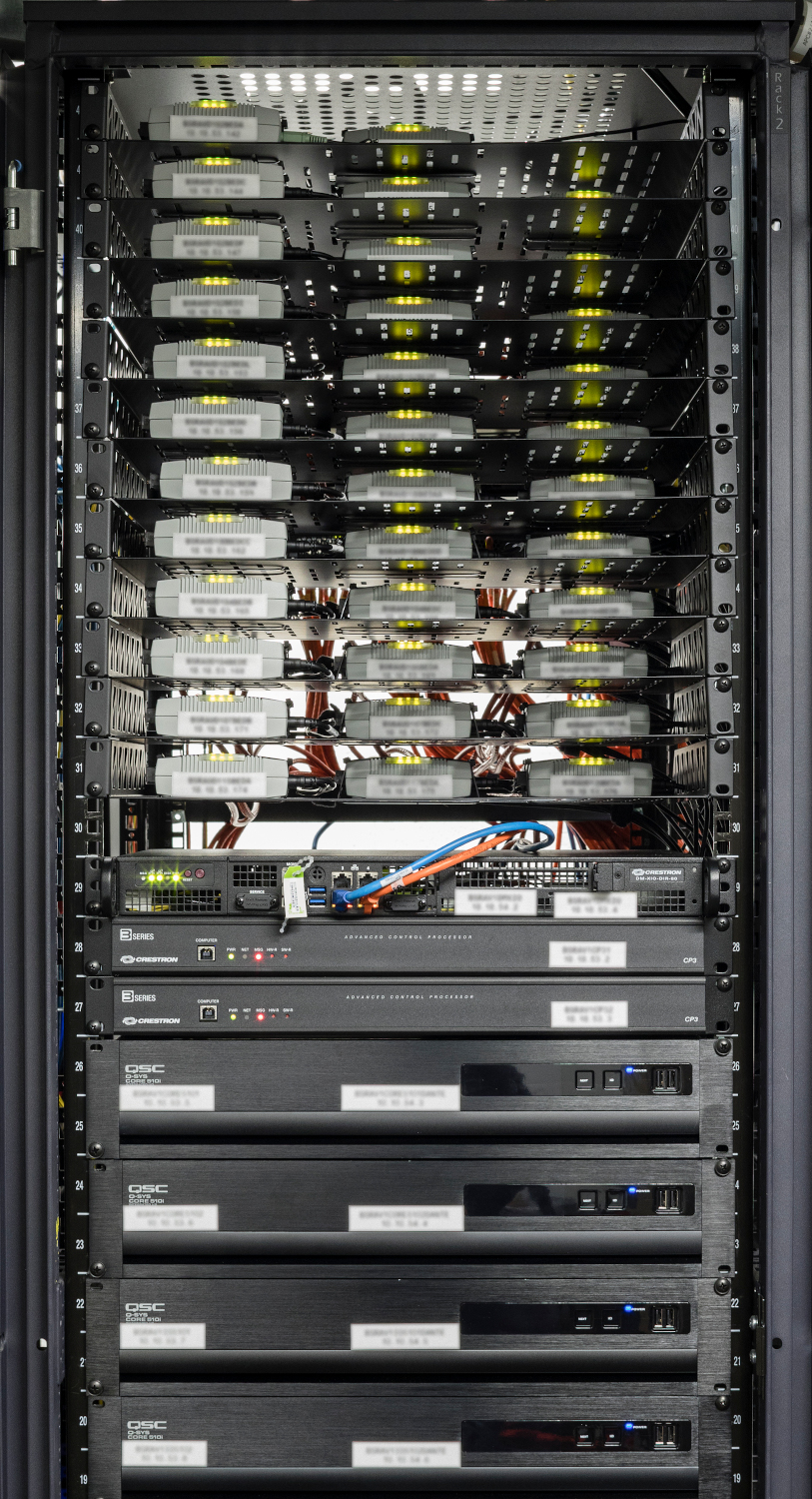
Complex and completed amid a global pandemic, Penn Nursing’s new education facility positions it for a future when much of medicine’s infrastructure will itself be net worked, a fact underscored by telemedicine’s explosive growth during COVID-19.
“All the improvements and enhancements that we envisioned over what we had before are in there,” Alexy, the IT Director, remarked. “We can plug in anywhere in a room, route anything to anywhere else or redress a room entirely for different applications. The flexibility we need is wired into the design and the end result. We’re not even close to using its full potential yet.”
This sprawling project represents the IP inflection point that AV integration has reached. “The last time we did this for the school, it was all analog,” Dempsey recalled, “with composite video, and RS232 jacks, and miles and miles of copper wiring.” He continued, “This time, all the audio and video traveled through their networks, requiring little to no field cables. The only analog cables needed were 35 analog in and 35 analog out to the B-Line endpoints. The amount of space that [was] freed up by using a network was enormous. The space that [previously] had been used for full-height AV racks has now been turned into an office—the racks replaced elsewhere with a small AV closet. This [helps] futureproof the entire campus, but it also is the future. The next time we do a project like this, this is the one I’ll look back on as the reference for it. We’ve seen the future, and it is working.”
EQUIPMENT
4-BAY ROOM 100
1 Attero Tech by QSC unD4O Dante/AES67 network audio interface
4 Attero Tech by QSC unDIO2x2+ Dante network audio interfaces
4 Audix GS1W installed-sound mics (white)
4 Audix M40W6S miniature high-output supercardioid ceiling mics w/6″ goosenecks (white)
8 Axis Communications M5525-E 2MP PTZ IP cameras
4 Axis Communications camera mounts for network cameras
4 Axis Communications T91L61 wall/pole mounts (black)
4 Chief RMT2 medium FIT tilt wall mounts
2 Crestron DM-NVX-352 DM NVX 4K60 4:4:4 HDR network AV encoders/decoders w/Dante audio
4 Crestron DM-NVX-D80-IOAV DM NVX 4K60 4:4:4 HDR network AV OPS decoders
1 Crestron HD-RX-101-C-E DM Lite HDMI-over-Catx receiver (surface mount)
1 Crestron HD-TX-101-C-1G-E-W-T DM Lite transmitter for HDMI signal extension over Catx cable
(wallplate, white, textured)
1 Crestron TSW-1060-B-S 10.1″ touchscreen (black, smooth)
1 Crestron TSW-1060-TTK-B-S tabletop kit for TSW-1060-B-S (black, smooth)
4 Ergotron 97-783 dual monitor and handle kits
1 Mersive SP-8000-E1 Solstice Pod wireless-collaboration device
1 Middle Atlantic U2 utility rackshelf (2RU, 14.75″D)
2 QSC AC-C6T full-range, ceiling-mount speakers
1 QSC SPA4-60 EnergyStar power amp
4 Sharp NEC Displays P484 48″ professional-grade, large-format displays
8 Shure MXW1/O=-Z10 bodypack transmitters w/integrated mics and 4-pin mini connectors
1 Shure MXWAPT8=-Z10 8-channel access-point transceiver
1 Shure MXWNCS8 networked charging station
8 Shure WL183 omnidirectional TQG lavalier mics
2 SoundTube ST-SS30-W Secret Sound 2″ high-directivity speakers (white)
18-BAY ROOM 102
2 Attero Tech by QSC unD4O Dante/AES67 network audio interfaces
18 Attero Tech by QSC unDIO2x2+ Dante network audio interfaces
2 Audio-Technica ATND8677a mic desk stands w/Dante network outputs
2 Audio-Technica U857QU UniLine condenser quick-mount gooseneck mics
18 Audix GS1W installed-sound mics (white)
18 Audix M40W6S miniature high-output supercardioid ceiling mics w/6″ goosenecks (white)
36 Axis Communications M5525-E 2MP PTZ IP cameras
18 Axis Communications camera mounts for network cameras
18 Axis Communications T91L61 wall/pole mounts (black)
18 Chief RMT2 medium FIT tilt wall mounts
1 Chief RPMAU RPA elite universal projector mount w/keyed locking (A version)
1 Crestron DMF-CI-8 DigitalMedia card chassis for DM-NVX-C and DMCF (8 slots)
1 Crestron DM-NVX-352 DM NVX 4K60 4:4:4 HDR network AV encoder/decoder w/Dante audio
6 Crestron DM-NVX-352C network AV encoder/decoder cards
18 Crestron DM-NVX-D80-IOAV DM NVX 4K60 4:4:4 HDR network AV OPS decoders
5 Crestron HD-RX-101-C-E DM Lite HDMI-over-Catx receivers (surface mount)
5 Crestron HD-TX-101-C-1G-E-W-T DM Lite transmitters for HDMI signal extension over Catx cable (wallplate, white, textured)
2 Crestron TSW-1060-B-S 10.1″ touchscreens (black, smooth)
2 Crestron TSW-1060-TTK-B-S tabletop kits for TSW-1060-B-S (black, smooth)
18 Ergotron 97-783 dual monitor and handle kits
10 JBL Control 26C 6.5″ ceiling speaker transducer assemblies
5 Mersive SP-8000-E1 Solstice Pod wireless-collaboration devices
2 Middle Atlantic U2 utility rackshelves (2RU, 14.75″D)
2 QSC SPA4-60 EnergyStar power amps
18 Sharp NEC Displays P484 48″ professional-grade, large-format displays
36 Shure MXW1/O=-Z10 bodypack transmitters w/integrated mics and 4-pin mini connectors
5 Shure MXWAPT8=-Z10 8-channel access-point transceivers
1 Shure MXWNCS4 networked charging station
4 Shure MXWNCS8 networked charging stations
36 Shure WL183 omnidirectional TQG lavalier mics
5 SoundTube ST-SS30-W Secret Sound 2″ high-directivity speakers (white)
5-BAY ROOM 104 WITH PROJECTOR
2 Attero Tech by QSC unD4O Dante/AES67 network audio interfaces
5 Attero Tech by QSC unDIO2x2+ Dante network audio interfaces
5 Audix GS1W installed-sound mics (white)
5 Audix M40W6S miniature high-output supercardioid ceiling mics w/6″ goosenecks (white)
10 Axis Communications M5525-E 2MP PTZ IP cameras
5 Axis Communications camera mounts for network cameras
5 Axis Communications T91L61 wall/pole mounts (black)
5 Chief RMT2 medium FIT tilt wall mounts
1 Chief RPMAU RPA Elite universal projector mount w/keyed locking (A version)
1 Crestron DM-NVX-352 DM NVX 4K60 4:4:4 HDR network AV encoders/decoders w/Dante audio
5 Crestron DM-NVX-D80-IOAV DM NVX 4K60 4:4:4 HDR network AV OPS decoders
1 Crestron TSW-1060-B-S 10.1″ touchscreen (black, smooth)
1 Crestron TSW-1060-TTK-B-S tabletop kit for TSW-1060-B-S (black, smooth)
1 Draper Silhouette V electric projection screen
5 Ergotron 97-783 dual monitor and handle kits
5 Mersive SP-8000-E1 Solstice Pod wireless-collaboration devices
1 Middle Atlantic U2 utility rackshelf (2RU, 14.75″D)
1 Panasonic PT-RZ660WU 6,200-lumen WUXGA DLP projector w/1.7 to 2.4:1 lens (white)
4 QSC AC-C6T full-range, ceiling-mount speakers
2 QSC SPA4-60 EnergyStar power amps
5 Sharp NEC Displays P484 48″ professional-grade, large-format displays
10 Shure MXW1/O=-Z10 bodypack transmitters w/integrated mics and 4-pin mini connectors
2 Shure MXWAPT8=-Z10 8-channel access-point transceivers
1 Shure MXWNCS4 networked charging station
1 Shure MXWNCS8 networked charging station
10 Shure WL183 omnidirectional TQG lavalier mics
5 SoundTube ST-SS30-W Secret Sound 2″ high-directivity speakers (white)
HOME CARE ROOM 106
1 Attero Tech by QSC unD4I-L Dante/AES67 network audio interface
4 Audix M40W6S miniature high-output supercardioid ceiling mics w/6″ goosenecks (white)
4 Axis Communications M5525-E 2MP PTZ IP cameras
4 Axis Communications camera mounts for network cameras
1 Crestron TSW-1060-B-S 10.1″ touchscreen (black, smooth)
1 Crestron TSW-1060-TTK-B-S tabletop kit for TSW-1060-B-S (black, smooth)
4 JBL Control 26C 6.5″ ceiling speaker transducer assemblies
2 Shure MXW1/O=-Z10 bodypack transmitters w/integrated mics and 4-pin mini connectors
1 Shure MXWAPT2=-Z10 2-channel access point transceiver
1 Shure MXWNCS2 2-channel networked charging station
2 Shure WL183 omnidirectional TQG lavalier mics
1 Stewart Audio AV25-2 NET-D 2-channel Dante subcompact amp
ROOM 107 WITH 4 TEMPORARY BAYS
3 Attero Tech by QSC unDIO2x2+ Dante network audio interfaces
3 Audix GS1W installed-sound mics (white)
3 Audix M40W6S miniature high-output supercardioid ceiling mics w/6″ goosenecks (white)
6 Axis Communications M5525-E 2MP PTZ IP cameras
3 Axis Communications camera mounts for network cameras
3 Axis Communications T91L61 wall/pole mounts (black)
6 Shure MXW1/O=-Z10 bodypack transmitters w/integrated mics and 4-pin mini connectors
1 Shure MXWAPT8=-Z10 8-channel access-point transceiver
1 Shure MXWNCS8 networked charging station
6 Shure WL183 omnidirectional TQG lavalier mics
HI-FI
4 Attero Tech by QSC unD4I-L Dante/AES67 network audio interfaces
4 Audix GS1W installed-sound mics (white)
12 Audix M40W6S miniature high-output supercardioid ceiling mics w/6″ goosenecks (white)
24 Axis Communications M5525-E 2MP PTZ IP cameras
20 Axis Communications camera mounts for network cameras
4 Axis Communications T91L61 wall/pole mounts (black)
4 Chief RMT2 medium FIT tilt wall mounts
4 Crestron DM-NVX-D80-IOAV DM NVX 4K60 4:4:4 HDR network AV OPS decoders
4 Crestron HD-TX-101-C-1G-E-W-T DM Lite transmitters for HDMI signal extension over Catx cable (wallplate, white, textured)
4 Crestron HD-TX-101-C-E DM Lite transmitters for HDMI signal extension over Catx cable
4 Ergotron 97-783 dual monitor and handle kits
4 Extron USB Extender Plus D T transmitters (Decorator-style version, white)
4 Extron USB Extender Plus D R receivers (Decorator-style version, white)
24 JBL Control 26CT 6.5″ ceiling speaker transducer assemblies
4 Mersive SP-8000-E1 Solstice Pod wireless-collaboration devices
4 Sharp NEC Displays P484 48″ professional-grade, large-format displays
8 Shure MXW1/O=-Z10 bodypack transmitters w/integrated mics and 4-pin mini connectors
4 Shure MXWAPT2=-Z10 2-channel access point transceivers
4 Shure MXWNCS2 2-channel networked charging stations
8 Shure WL183 omnidirectional TQG lavalier mics
CONTROL ROOM
6 Audio-Technica ATND8677a mic desk stands w/Dante network outputs
6 Audio-Technica U857QU UniLine condenser quick-mount gooseneck mics
6 Crestron DM-NVX-352 DM NVX 4K60 4:4:4 HDR network AV encoders/decoders w/Dante audio
6 Crestron TSW-1060-B-S 10.1″ touchscreens (black, smooth)
6 Crestron TSW-1060-TTK-B-S tabletop kits for TSW-1060-B-S (black, smooth)
4 Middle Atlantic DOOR-S12 Essex solid doors (12RU)
4 Middle Atlantic MMR-1220 MMR Series racks (12RU, 20″D)
2 Stewart Audio DSP100-2-CV-D 2-channel, DSP-enabled amps
DIGITAL SIGNAGE
10 BrightSign HD224 standard I/O players
9 Chief FTR1U small flatpanel tilt wall mounts
1 Chief RLT2 large FIT tilt wall mount
9 LG Electronics 22SM3B-B SM3B 22″-class (21.5″ viewable) LED displays (full HD)
1 Samsung QB65R 65″ edge-lit 4K ultra-HD LED display for business
BASEMENT SERVER ROOM
1 APC SMC1500-2UC Smart-UPS (1,500VA, rackmount, LCD, 120V)
10 Axis Communications M5525-E 2MP PTZ IP cameras
2 Crestron CP3 3-Series control systems
1 Crestron DM-XIO-DIR-80 DigitalMedia XiO Director virtual switching appliance
5 QSC CDN64 Dante audio bridge cards
3 QSC Core 510i Q-SYS integrated core processors
ATTIC STOCK
35 Axis Communications P8221 network I/O audio modules
1 BrightSign HD224 standard I/O player
10 C2G 39702 HDMI and USB pass-through wallplates (white)
35 C2G 40107 25′ 3.5mm stereo audio cables w/low-profile connectors M/M (in-wall, CMG-rated)
1 Chief FTR1U small flatpanel tilt wall mount
2 Crestron DM-NVX-352 DM NVX 4K60 4:4:4 HDR network AV encoders/decoders w/Dante audio
4 Crestron HD-RX-101-C-1G-E-B-T DM Lite HDMI-over-Catx receivers (wallplate, black, textured)
5 Crestron HD-RX-101-C-E DM Lite HDMI-over-Catx receivers (surface mount)
5 Crestron HD-TX-101-C-E DM Lite transmitters for HDMI signal extension over Catx cable
9 Elo E045538 1502L 15″ touchscreen monitors (rev A)
5 Ergotron 45-505-216 MXV wall monitor arms (white)
1 Extron SW4 HD 4K 4-input HDMI switcher
1 LG Electronics 22SM3B-B SM3B 22″-class (21.5″ viewable) LED display (full HD)
1 Mersive SP-8000-E1 Solstice Pod wireless-collaboration device
5 Mersive SP-8301-E Solstice Pod Gen3 power supplies
12 Middle Atlantic U1V utility rackshelves (1RU, 10.4″D, vented)
1 Middle Atlantic VTF2-CP12 vent panel (2RU, perforated, 25% open area, 12-piece contractor pack)
1 QSC CDN64 Dante bridge card
12 QSC CIML4 mic/line analog input cards
12 QSC COL4 analog line output cards
1 QSC Core 510i Q-SYS integrated core processor
List is edited from information supplied by Solutionz, Inc.
To read more installation features from Sound & Communications, click here.
